What is Power?
- People experience influence through power in various aspects of life.
- It is associated with politics; however, it is not the only domain of use.
- A company’s executives should learn how to apply power and utilize it in their work efficiently.
- Abuse of power is the primary issue of leadership.
In general, the term is associated with politicians and their activities due to the fact that their work relates to utilizing their position for managing various aspects of country governance. However, any organization and its executives have to use power as part of their leadership as well.
Nahavandi (2014) states that by “using their power, department heads, CEOs, and city mayors implement strategies to achieve organizational goals” (p. 78).
Unfortunately, sometimes people overestimate their impact (most evidently executives that receive many privileges as part of their high-level positions in organizations), thus abusing power and corrupting its meaning and importance. Therefore, it is crucial for one to understand various aspects of power, the ways in which it should be applied, and the impact it has on a leader’s followers.
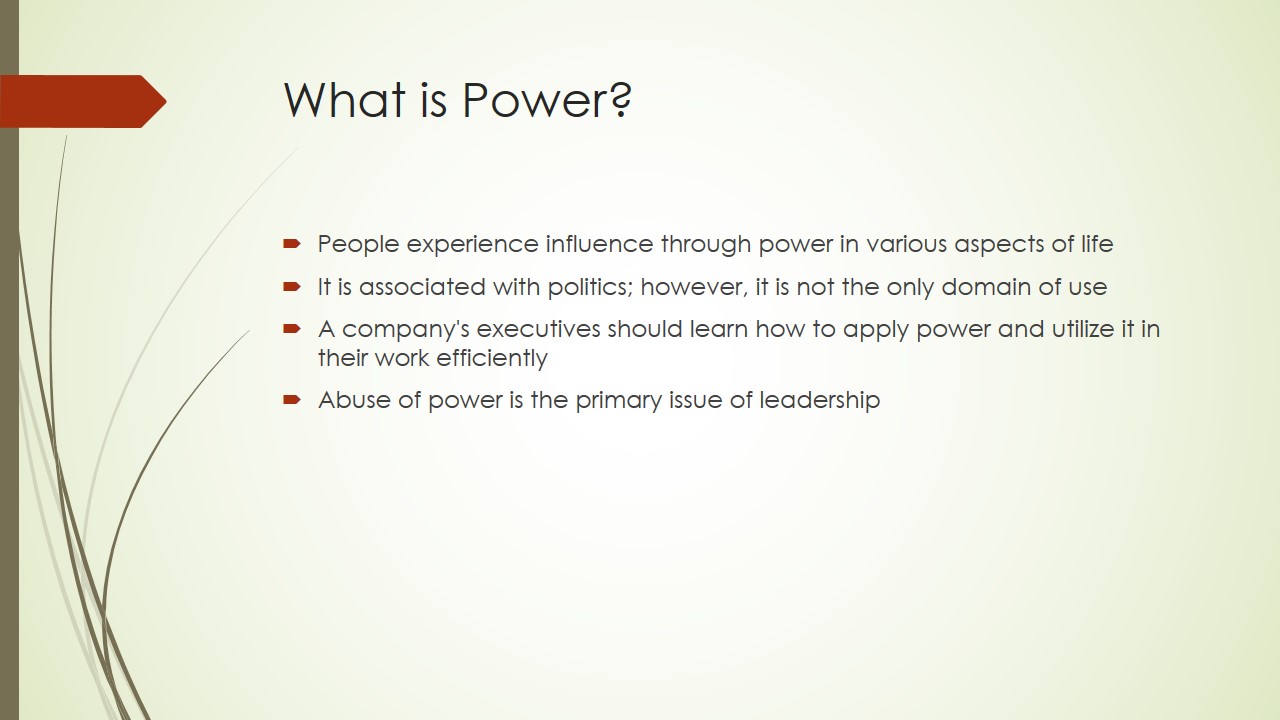
Explanation of Power
- “Power is the ability of one person to influence others or exercise control over them” (Nahavandi, 2014, p. 71).
- Leadership theories explore how executives utilize the power.
According to Nahavandi (2014), the term is commonly associated with influence and authority. Moreover, the three often are utilized interchangeably; thus they are close in meaning. Due to the fact that contemporary leadership theories are focused on the personal characteristics of an individual and their development, an examination of power as a contributing factor to an executive’s success is necessary. According to Nicholson and Carroll (2013), “leadership development theory and practice is increasingly turning its gaze on identity as a primary focus for development efforts” (p. 1125). It can be argued that developing characteristics that affect one’s impact is impossible; however, exploration of power sources provides an understanding that various factors are connected to the issue.

Power and Leadership
- The two aspects should be utilized together to manage people successfully.
- According to Nahavandi (2014), tasks would not be accomplished if leaders did not have power.
- Power both provides influence for executives and affects the employees.
The connection between the two is strong, as both cannot exist without one another. Nahavandi (2014) states that “power and leadership are inseparable” (p. 70). Thus, a person who strives to be a leader should understand how successful executives utilize their power. For the most part, managers require power to ensure that their followers adhere to the standards and tasks they set for an organization.
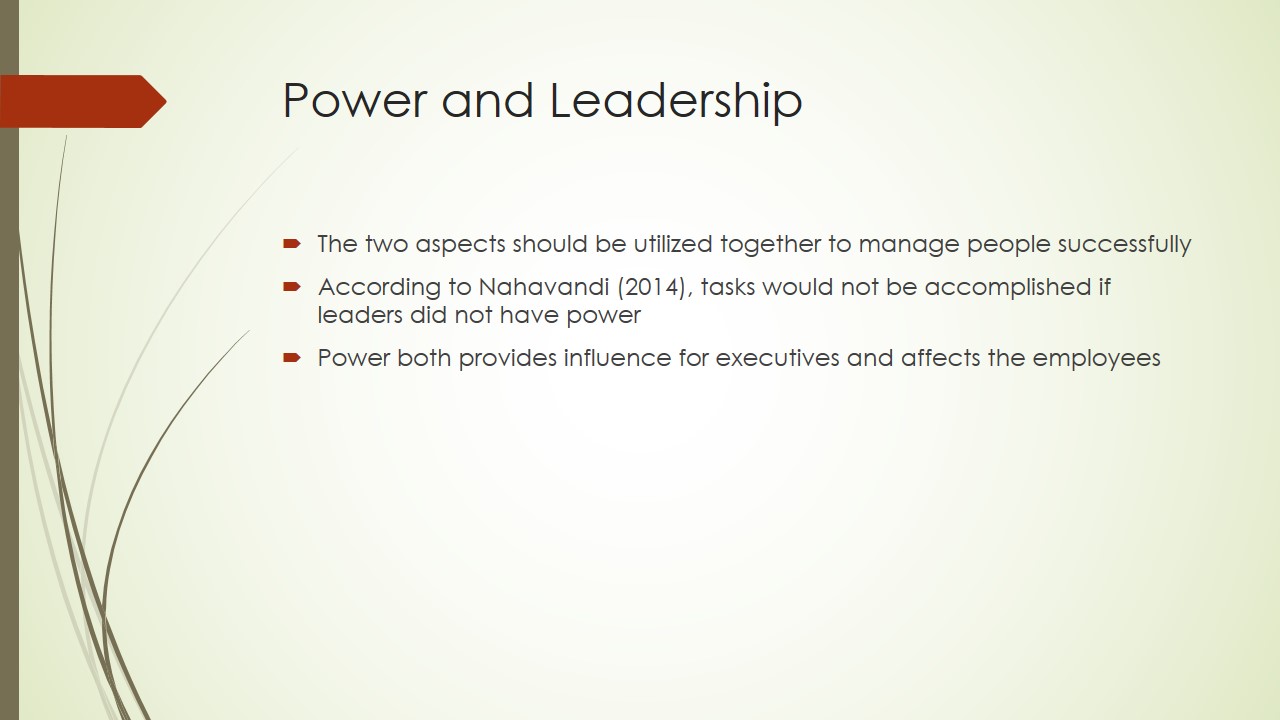
Having Power
Nahavandi (2014) states that there are specific characteristics that distinguish those who have power from people who do not possess it. Those are:
- Orientation on performing actions.
- Highly developed interpersonal skills.
- Adherence to rules (which may result in ignoring the outcomes).
- Demonstrations of generosity.
Although people in their everyday lives have power over their actions and others, the executives can be distinguished by particular qualities. In addition, power increases the distance between a leader and his followers. The issue proves to be problematic as it affects the ability of a leader to make fair decisions for an organization.
Furthermore, Nahavandi (2014) states that those with power may develop an addiction to it and become less empathetic to other people. They can credit themselves for the success of their followers. Thus, power affects significantly one’s perception and the relationship with employees.
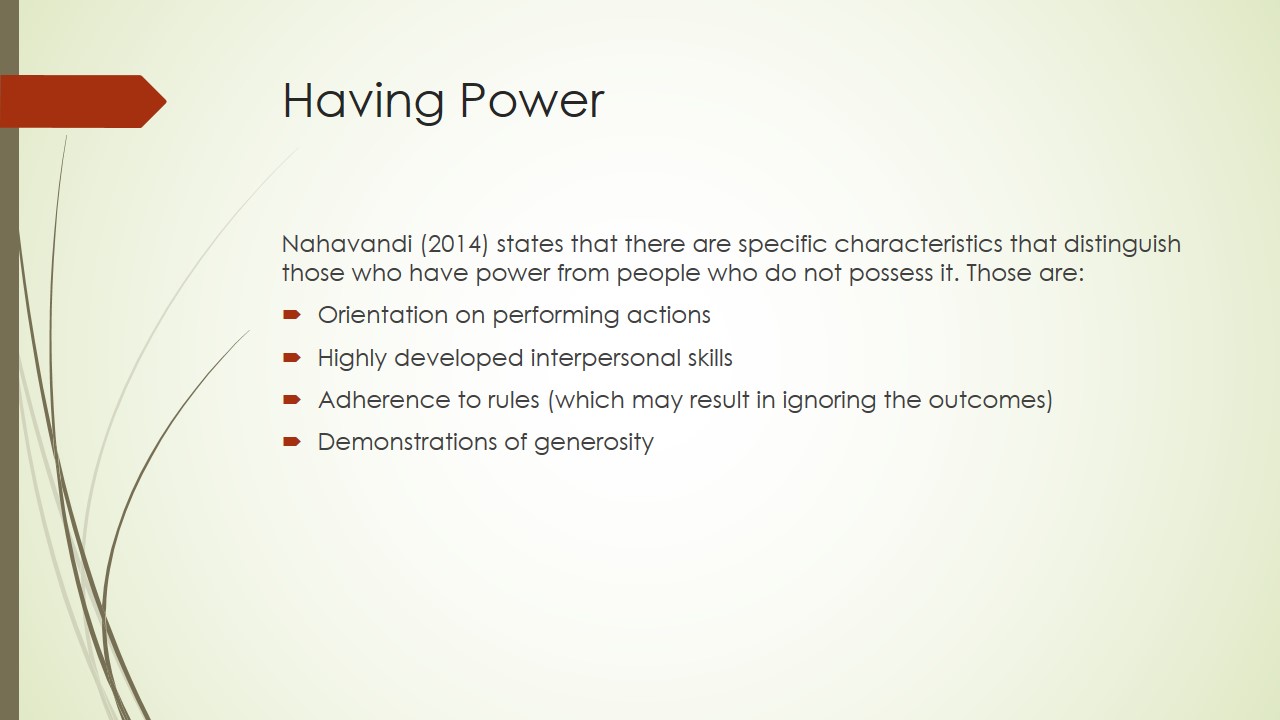
Basis of Power
“Etzioni (1964) differentiated three types of power bases that leaders may use, namely:
- physical power, entailing the use of threats or coercion;
- material power, entailing the use of rewards; and
- symbolic power, entailing the use of normative or social power” (as cited in Antonakis and Day, 2018, p. 30).
The symbolic power of a leader lies in his or her personal qualities, more specifically in charisma. Such a person can utilize the trait as a source of authority, thus ensuring that employees are more committed to performing tasks. According to Antonakis and Day (2015), when one chooses to use symbolic power over other approaches, the outcomes (including employee commitment and lesser alienation) are better.
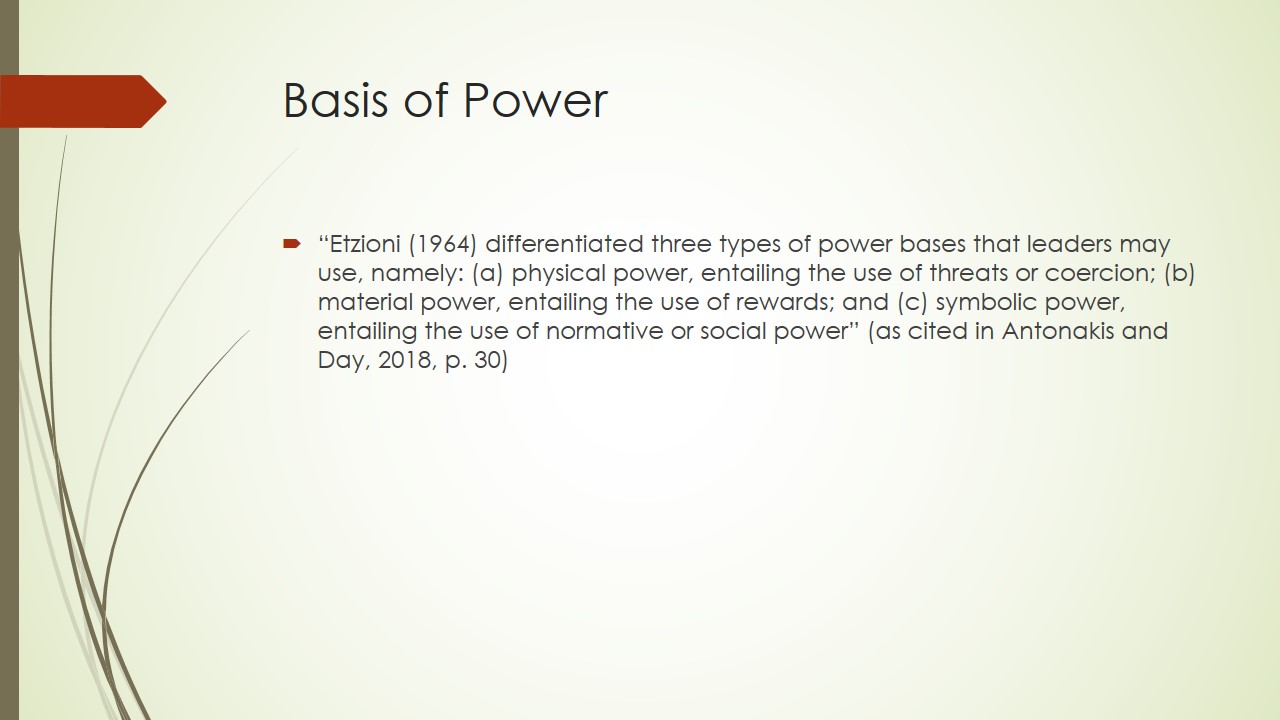
Summary of Power and Leadership
- “As a general rule, a leader’s power increases when employees are personally committed and accept the leader’s ideas and decisions” (Nahavandi, 2015, p. 71).
- Ensuring that power is evenly distributed throughout an organization is crucial to guarantee the efficiency of operations.
- Executives who chose to use their power adversely may encourage deviant behaviors in their personnel.
The positive use of power focuses on persuading employees to comply with a plan of action, while a negative one utilizes power to order people what to do.
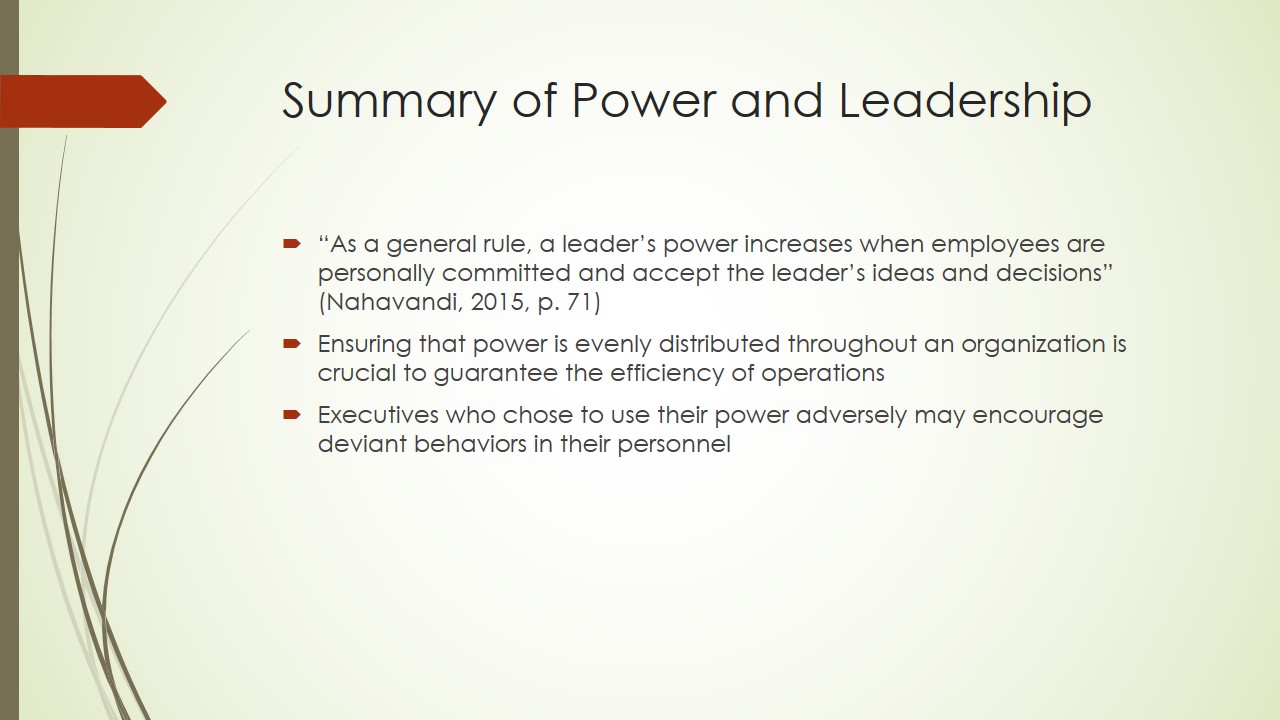
The Five Sources of Power
- French and Raven have developed the theory of five power sources in 1968 (Nahavandi 2015).
The five sources are:
- legitimate;
- reward;
- coercive;
- expert;
- referent.
One should utilize various power approaches, while mostly relying on personal resources.
The five differ from each other in the ways one utilizes them to influence others. Nahavandi (2014) states that legitimate, reward and coercive types depend on a position a particular person has in a company. Thus, it provides and seizes power in cases where it is necessary (for instance by promoting an executive, therefore, granting him more power).
The two final sources (expert and referral) do not rely on an establishment; furthermore, they are based on a particular person’s characteristics (for instance a person who is respected has power over those who admire him or her).
It is essential to understand that the influence a leader has on his followers depends directly on the nature of the power source. It can affect the level of commitment or resistance to a deciding.
A leader should combine the five powers to efficiently manage people. Thus, Figure 1 demonstrates the importance of this aspect as leveraging the sources will result in efficient work process.
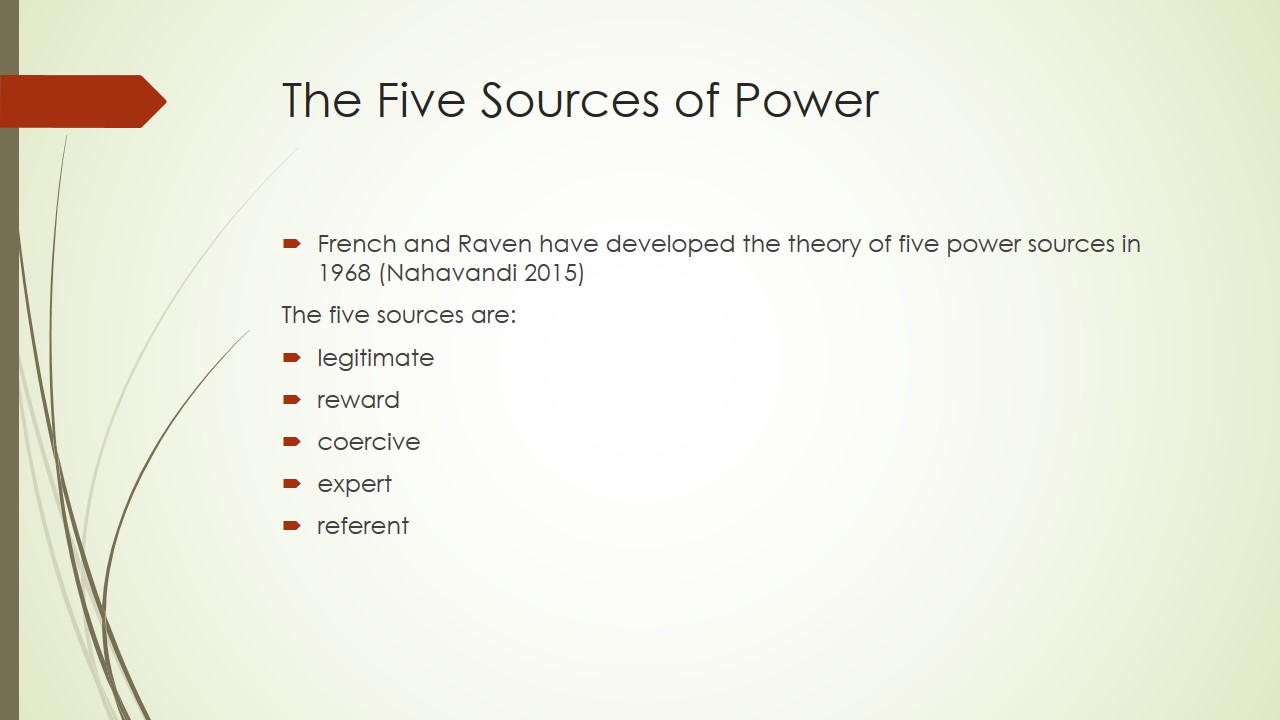
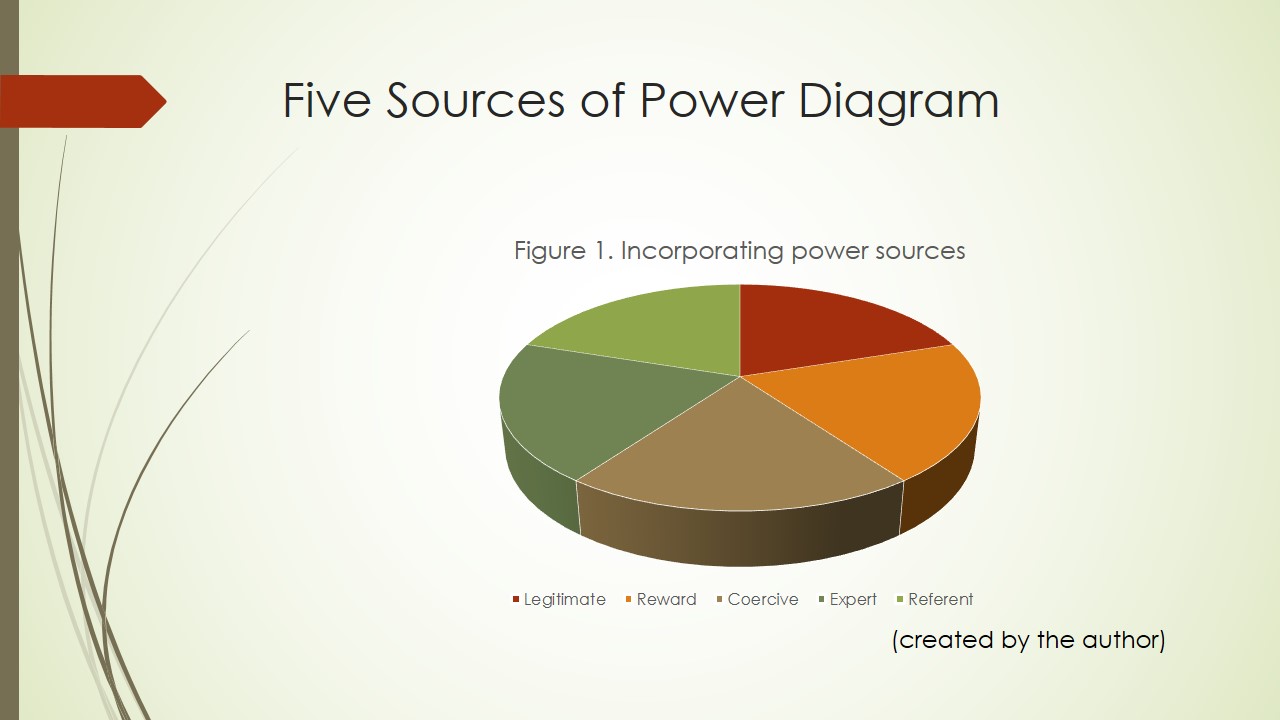
The Five Sources of Power – Legitimate Power
- This type is solely based on a position an individual holds.
- The compliance of followers depends on their position in a company.
The name of the power source suggests that the primary reason to follow orders of a legitimate leader is that he was granted a right to make decisions (such as delegate tasks, review employees work, generate strategic plans) by an organization. The nature of the power comes from a belief that a person has a right to make requests (Nahavandi, 2015). Thus, a manager appointed by a CEO of a company will have legitimate power over his departments, as the company gave the person a right to make choices on how to ensure efficient work. Any executive can utilize this power source as a primary influence approach. It can be argued, however, that such method is not enough for the effective functioning of an organization. Other power sources offer different perspectives on motivation and compliance (through personal characteristics, attractiveness, ability to rewards or penalize).
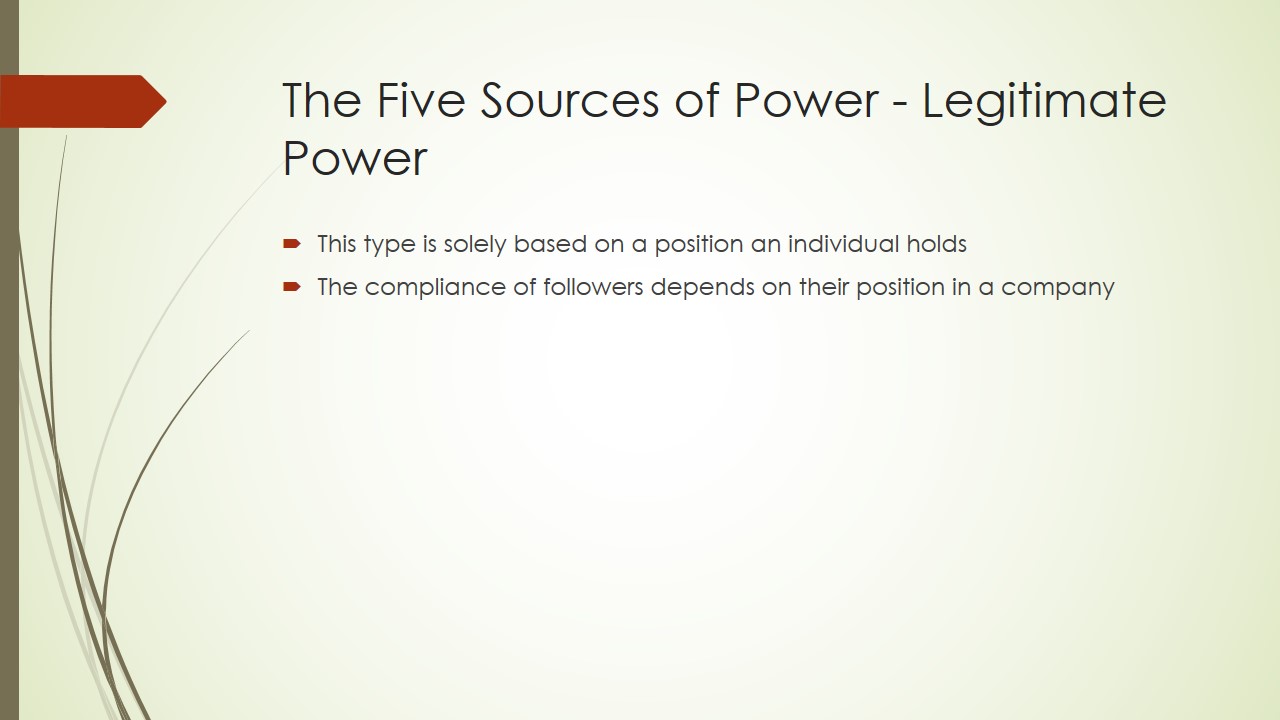
The Five Sources of Power – Expert Power
- Expert power is based on personal experience, knowledge, and other useful characteristics that result in an individual being respected by others (Nahavandi, 2015).
- The followers comply with such a leader’s decisions, as they trust his capabilities.
This type of power does not necessarily imply that a person is an executive in a company (thus, a staff member may have more expertise in a particular area and have more expert power). In case others think that an individual (for example a coworker) has enough understanding and skill to make proper decisions, they will listen to his or her suggestions. Thus, it is essential for an organization to ensure its CEO has the required amount of expert power. It is a guarantee that employees would respect decisions that the executive makes and that they perform their work with diligence.
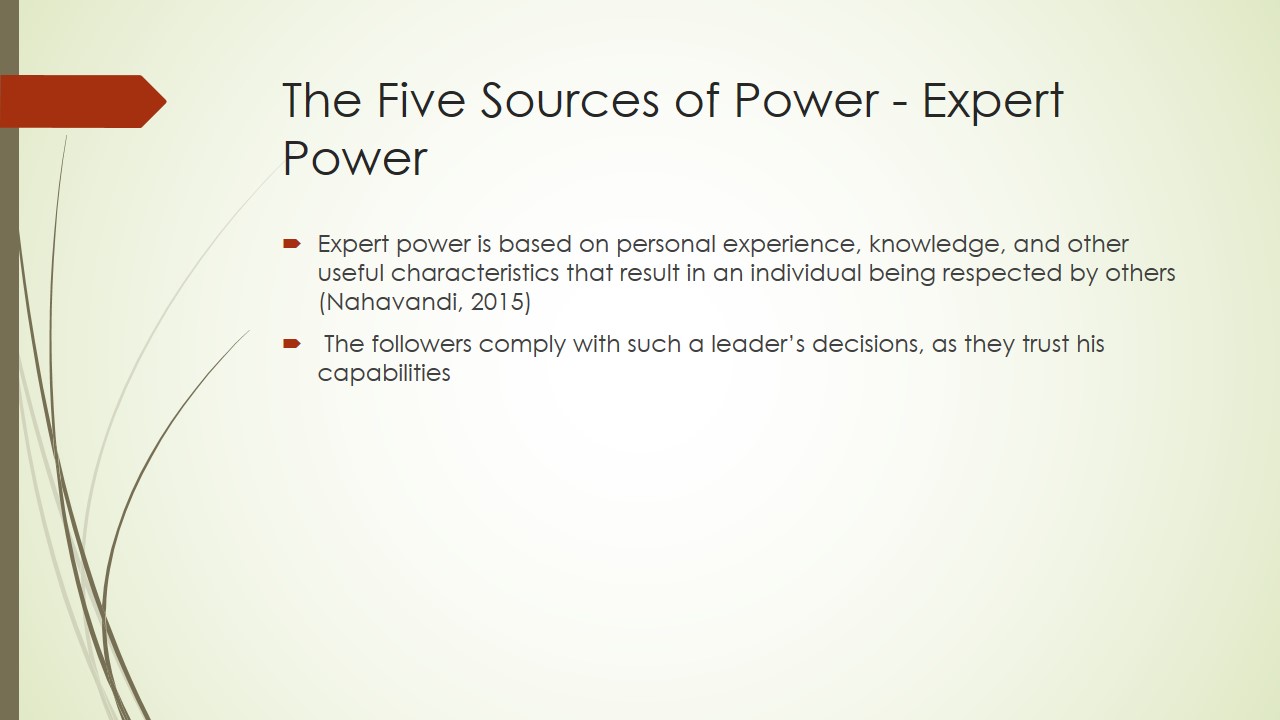
The Five Sources of Power – Coercive Power
- It can be described as a negative subtype of power as it is based on threatening and punishing the employees.
- Coercive power should be utilized with caution to ensure that people working in the company follow the rules.
- A balance between using this power and other sources is required to counteract possible defiance (thus, rewarding when the employees do a good job and employing penalties when they fail severely at a task).
This power source implies that a manager can utilize his position in an establishment to create difficult work conditions for others (for instance have strict deadlines). In case of noncompliance, such a person would use his or her title to penalize staff members (by cutting salaries or terminating cooperation). It is evident that the power source does not provide a positive work environment for employees; therefore, it should be avoided.
However, it can be necessary in some cases, as the approach may be the only factor that ensures the employees perform their daily tasks.

The Five Sources of Power – Referent Power
- The followers’ respect and like the power holder.
- The nature of the source is based on personal attractiveness.
- It can be argued that it is difficult to employ this source as it relies on inborn qualities and traits (such as a person’s looks and charisma).
This type solely relies on the personality of the individual and character traits. Both respect and approachability are essential for this source, as they ensure that others would comply with the decisions of an individual. As with other categories, referent power can be utilized not only by executives but by other staff members as well.
While it may be challenging to develop referent power, a proper work on one’s qualities (for instance on communication skills) can be beneficial.

The Five Sources of Power – Reward Power
- An executive can reward his workers; thus, the opportunity presents him with a power source.
- People follow the leader with such approach as they want to receive compensation for their actions.
- It can serve as an additional motivator for personnel.
- Unjustifiably favoring someone would adverse the effects of the method.
An individual who can decide how to distribute rewards in an organization holds this power. It can be connected to a variety of bonuses and benefits that a company provides for its staff. The positive effects of the identified power are that it can be utilized to ensure that employees pay particular attention to a specific task, by offering them something apart from their salary. While beneficial in general, reward power can affect the motivation of personnel negatively if they think a specific worker is receiving rewards without apparent reasons. Thus, it is a task of a leader to clarify the conditions under which the benefits are distributed to ensure proper work environment.
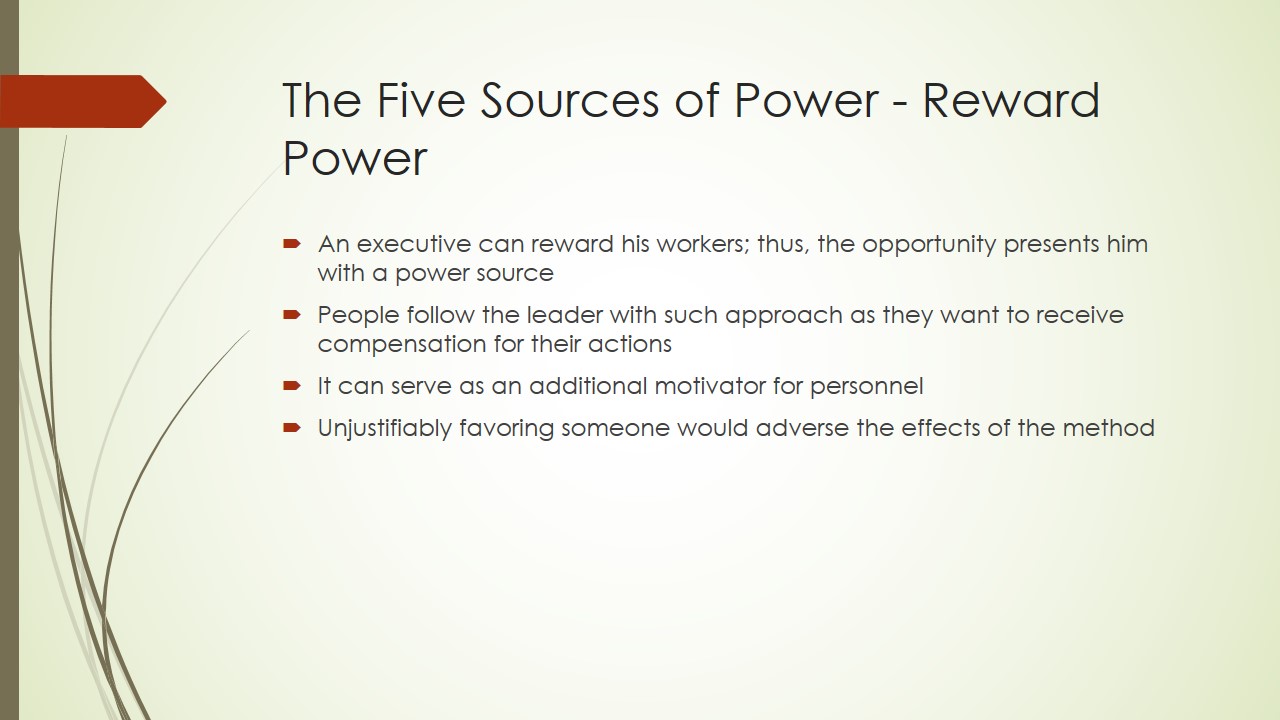
Summary of the Relationship Between Influence and Power
- Nahavandi (2014) states that “Influence is the power to affect or sway the course of an action” (p. 79). Thus, both power and influence are similar as they describe an impact one person can have on another (or on specific events).
- A CEO with legitimate power may not be able to influence the employees as other sources are not utilized.
- Influence tactics(summarized by various researches over the years) can help increase influence over people (Nahavandi, 2014).
People do not have to hold an executive position to be able to execute their influence. For instance, customers can impact the level of service provided to them (thus they can affect the company’s operations). One should choose an appropriate influence tactic (out of nine) that is suitable in a particular situation. By doing so, an executive will maximize the power effect and leadership.
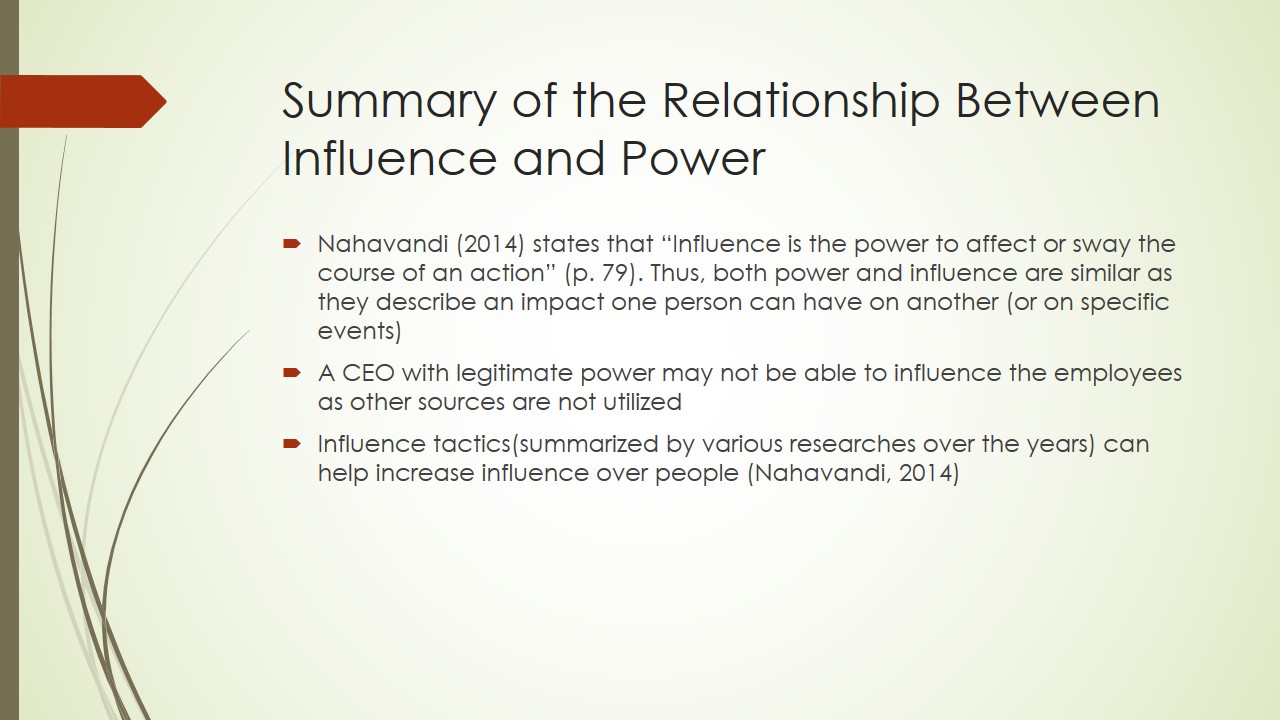
Nine Influence Tactics
The nine tactics of influence are:
- Rational persuasion;
- Inspirational appeal;
- Consultation;
- Ingratiation;
- Personal appeal;
- Exchange;
- Coalition building;
- Legitimate tactics;
- Pressure (Nahavandi, 2014).
Morgan (2015) states that “we’ve all encountered people who say less but what they say matters more” (para. 1). It is due to the fact that some know how to employ adequate approaches to maximize their influence and power.
Each of the strategies relates to a power source, for instance, the personal appeal has a connection to referent power (which is based on one’s ability to be attractive). Thus, tactic and power source together synthesize an approach that can help resolve particular situations (for example when help from a coworker is needed personal relationship can be beneficial).

Relationships between Leaders and Staff
- The relationship between an executive and personnel is an essential factor that determines the work environment.
- Leadership is more connected to influence then to power, as it implies close cooperation with followers.
Although power and influence are very similar, Kuhel (2015) argues that there is an essential difference between the two. According to the author, leaders who want to influence others to seek to ensure their personnel grows and improves, while merely employing power can result in improper motivation and inability to succeed for a company. Thus, a proper relationship between an executive and employees is necessary. As was previously mentioned, power can be tempting, and some engage in abusing it due to a variety of reasons. However, a successful CEO of the company should understand that both power and influence are tools that should be utilized only for the benefit on an organization and its staff members.
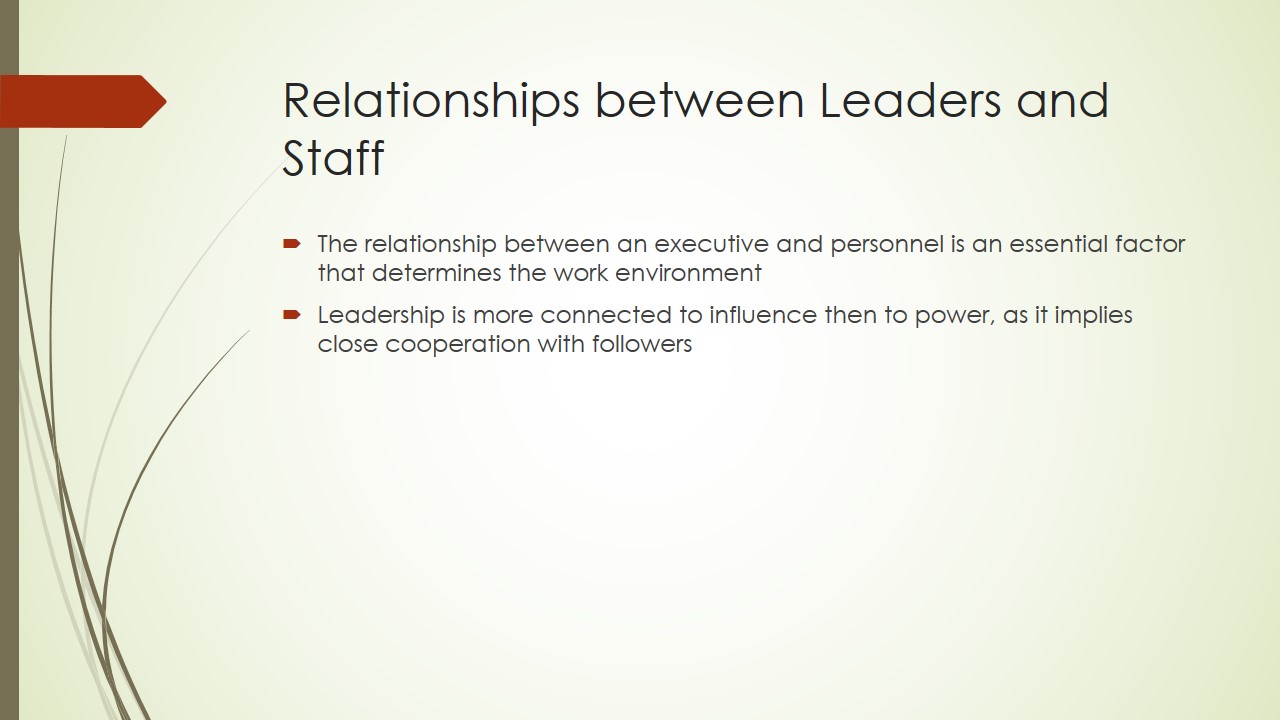
Conclusions
A successful leader should:
- Synthesize the power sources available to him or her.
- Utilize them strictly to promote a positive environment within the organization.
- Be aware of abuse and addiction to power.
- Use influence techniques to maximize the effectiveness of power.
- Understand the importance of influence in the relationship with employees.
The modern leadership theories are moving towards understanding how a leader impacts his or her followers (and what approaches can help enhance the effects of it). The power sources and influence techniques mentioned above provide an understanding of the factors that result in employee compliance. It is evident that executives have a variety of approaches available to them that can ensure they are respected and listened to in an organization. While granted power provided by an establishment is essential as it presents necessary mechanisms to be in a decision making position, establishing oneself as a skilled, knowledgeable, and rewarding leader is crucial as well.
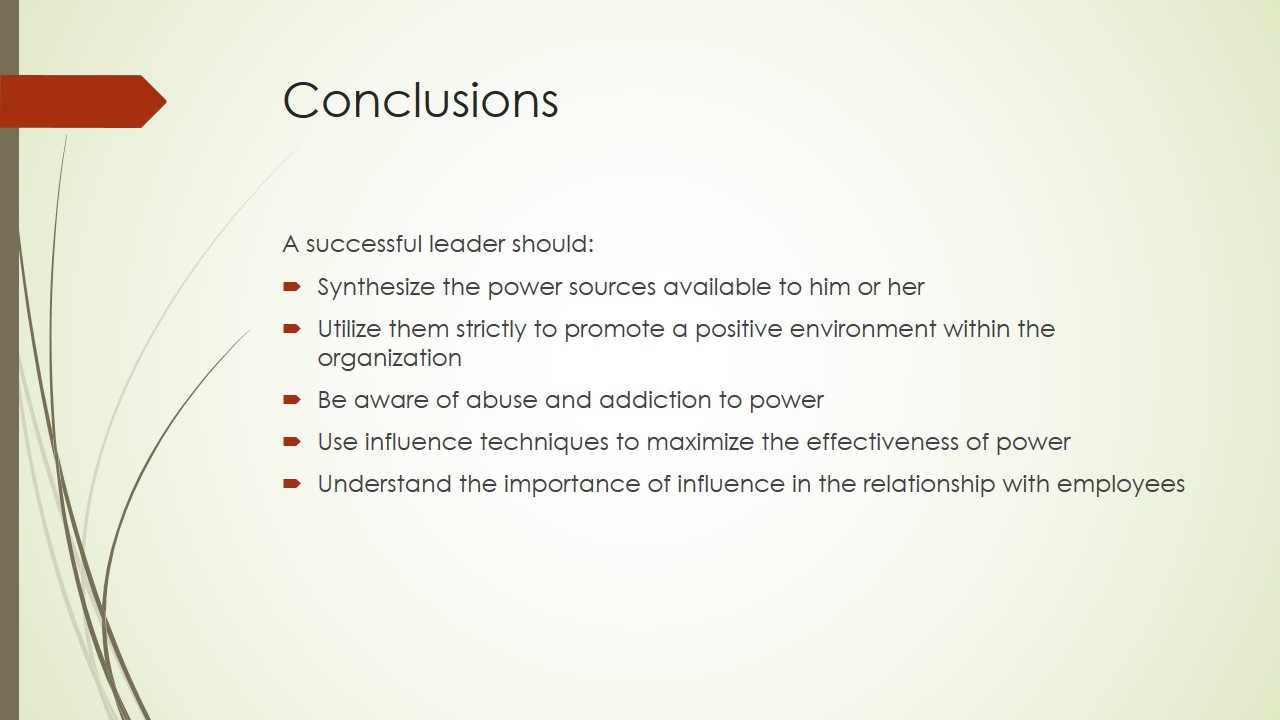
References
- Antonakis, J., & Day, D. V. (2018). The nature of leadership (3rd ed.). Thousand Oaks, CA: SAGE.
- Kuhel, B. (2017). Power vs. influence: Knowing the difference could make or break your company. Forbes. Web.
- Morgan, N. (2015). Understand the 4 components of influence. Harvard Business Review. Web.
- Nahavandi, A. (2014). The art and science of leadership (7th ed.). New Jersey, NY: Pearson.
- Nicholson, H., & Carroll, B. (2013). Identity undoing and power relations in leadership development. Human Relations, 66(9), 1225-1248.